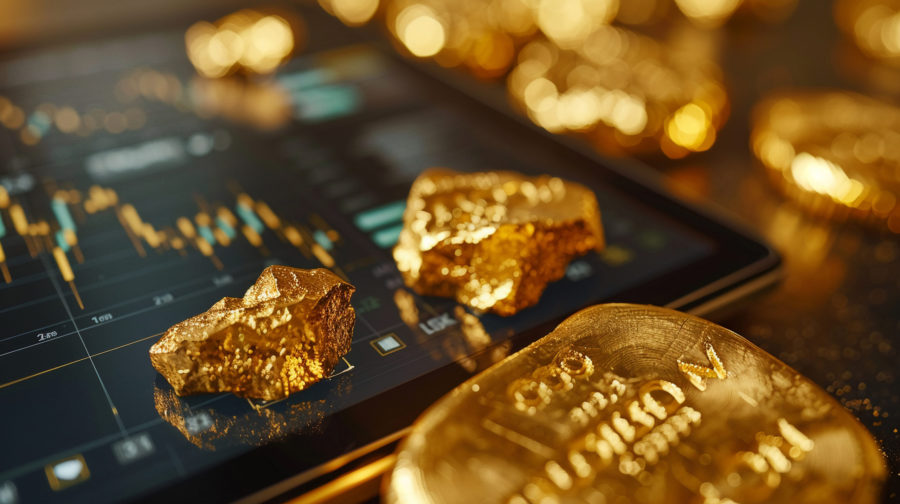Florian Siegfried: We have to distinguish between the short term and medium term and take an overall picture of where we stand. Gold has found a floor at the $1,280/ounce gold ($1,280/oz) level, which is encouraging for the short term. If we are in fact in the late stages of a good basing action in gold, that means the speculative money will go back not only to the metal, but also mining shares in anticipation of higher gold prices.
If we move below $1,280/oz in the short term, the bears will remain in the driver’s seat for at least a few weeks, perhaps months.
TGR: And in the medium term?
“Asanko Gold Inc.’s world-class deposit is on the radar screen of many companies.“
FS: If we see a continued rotation out of broad market equities and into precious metals then I would say, yes, the bear is dead. An encouraging sign that the bear is indeed dead is that gold is rising against the U.S. dollar and precious metals shares are largely outperforming the metal itself. This is encouraging but it doesn’t yet confirm anything.
TGR: If the gold price falls below $1,280/oz, how many months could the bear stick around?
FS: Midcycle corrections in gold tend to last up to four years. It has been more than three years now, probably 3.5 for the miners. I wouldn’t be surprised to see a sideways trend for the next six months, if we go by past cycles.
TGR: Share prices seem to be getting ahead of metals prices. Do you expect that to even out or continue?
FS: If we see continuing weakness in equities and bonds, this rotation into precious metals will continue. But if we see heavy liquidation in stocks and rising yields in the junk bond market as liquidity evaporates, precious metal shares will not outperform gold because the sage money will primarily go into gold itself. As long as we remain in this rotation, I would expect shares to outperform the metal in the medium term.
“Victoria Gold Corp. continues to drill and make higher-grade discoveries in its Olive zone.“
TGR: Some of the companies that you follow are performing well year-to-date: Kirkland Lake Gold Inc. (KGI:TSX) is up 60%, while Lake Shore Gold Corp. (LSG:TSX) is up about 170%. What do those companies have in common?
FS: Lake Shore Gold and Kirkland Lake are turnaround situations. Lake Shore Gold was extremely oversold last year and the stock was trading at $0.16/share in June 2013. Basically, it refinanced its business in 2012 before the gold price collapsed by raising the necessary debt and convertible debentures to improve operations. It stabilized the grade and costs went down.
Kirkland Lake is a similar case. The new management team has started to bear fruit. Kirkland is focused on fewer higher-grade stopes in order to reduce tonnage and dilution. Costs have gone down but it’s an ongoing process. The expansion capital projects are basically completed, however, the balance sheet has little room for operational errors. Both stocks are performing better than the index year-to-date, but they also lost a lot in the downturn.
TGR: Are turnaround stories the sweet spot for precious metals investors?
FS: This is where you can have the best returns if the market continues to go up. It’s about being selective and trying to find turnaround candidates. The problem is that many companies are cutting capital expenditures (capex) to reduce their all-in costs, which lifts profits temporarily but poses new problems in the longer run. Lots of stocks are 80–90% below their all-time highs and they’re down for a reason. You have to find the ones that have stabilized their operations and that have sufficient cash to go through the restructuring period as they make operational progress. At $1,300/oz gold few producers make much money but they have leverage to the gold price. When the gold price shoots higher, these companies should become very profitable. You can still buy them at depressed valuations at this stage.
TGR: Let’s go back to the fundamentals. Tocqueville Gold Fund’s John Hathaway recently told The Gold Report that the bottom of the precious metals complex will be confirmed when gold trades above $1,400/oz. Your thoughts?
FS: We should see a close around $1,330/oz in the short term. That would confirm a breakout for me in order to see $1,400/oz. Gold has been trading sideways between $1,280/oz and $1,330/oz for several months. A breakout above this level would confirm the next leg up.
TGR: Mining is largely a sentiment driven market. What is the current sentiment among investors and money managers that you talk with?
FS: The traditional gold equity funds have mostly stabilized after the drop last year, but they are basically not seeing big inflows from the traditional investor base. Those investors have largely sold out. Interestingly, there are many first-time buyers, including private equity, investing in the sector because it is ridiculously cheap at this point.
In Asia, investors are more into the high-beta stocks or turnaround stories. Overall, the sentiment toward gold and precious metals in Europe is definitely much more supportive than in North America.
TGR: How much of an impact are Asian investors having in the space versus what was happening three to five years ago?
FS: A lot of Asian institutions sold out just as everyone else did because those funds received the same redemptions as everyone else. The mood probably remains quite depressed, but the difference is that they are trying to play the next upswing by picking up those fallen angels, the midtier producers that are priced at much lower valuations than the senior stocks like Newmont Mining Corp. (NEM:NYSE) or Barrick Gold Corp. (ABX:TSX; ABX:NYSE). Selective buying from Asia has given the market some support.
TGR: What are European investors seeking when it comes to precious metals equities?
FS: For European investors looking for gold mining companies, it’s all about quality, management, profits and sustainable operations. Investors are increasingly selective. In the last run up in 2009–2011, an investor could virtually buy any company with gold in its name and it went up when gold went up. A rally has been in place since the beginning of the year but not every stock is joining in. It’s now about stock picking.
TGR: You’re not a geologist but you have a background in finance and a fair amount of experience in this space. How do you vet these companies?
FS: I make a short, diversified list of companies. There are hundreds of names but in the end I end up with probably 50–60 that I can really track. It’s a risky business. I have to consider all the different factors—financials, management, jurisdictions. I eventually try to pare the list down to the best names.
TGR: What are your investment strategies to get the most out of the next move in the cycle?
FS: Investors have to have a core portfolio of low-cost, well-financed junior and intermediate producers because that is where the music is playing if mergers and acquisitions (M&A) activity continues. Increase positions where you see momentum gaining strength because this is a market driven by momentum and sentiment.
For turnaround situations, I prefer 100,000–200,000/oz (100–200 Koz) gold producers that are bottoming, demonstrating quarterly operational progress and have cash in the bank. But only selectively build positions on the down days because those equities remain volatile in this market.
For M&A, the developers that are fully financed or fully permitted will take center stage in the next M&A wave. I would definitely have some exposure there.
If we see higher gold prices in the next few quarters, I also like cheap advanced-stage exploration stocks trading between, say, $0.10–$0.30/share. These stocks are basically an option on gold.
TGR: So you are saying the music is playing the junior and intermediate producers space for M&A?
FS: Let’s look at B2Gold Corp. (BTG:NYSE; BTO:TSX; B2G:NSX) takeovers of Volta Resources Inc. and Papillon Resources Inc. Those were junior names. If you buy a company for valuation purposes, there are definitely plenty of opportunities in this sector and that will attract suitors. You said that Market Vectors Junior Gold Miners ETF is up 30% versus the Market Vectors Gold Miners ETF, which is up only 22%. That, for a good part, reflects growing M&A speculation.
TGR: Are there large caps that will be seeking to fill some needs via M&A?
FS: Possibly Goldcorp Inc. (G:TSX; GG:NYSE) because it has the balance sheet to make transactions. Agnico-Eagle Mines Ltd. (AEM:TSX; AEM:NYSE) and Yamana Gold Inc. (YRI:TSX; AUY:NYSE; YAU:LSE) just completed the Osisko deal. Barrick remains in divesting mode as it fixes its balance sheet. It has to define a new strategy before it considers acquisitions. Newmont and Kinross Gold Corp. (K:TSX; KGC:NYSE) are in similar positions. They all acquired companies at the top of the market and have had huge write-downs. I don’t see those companies entering into M&A in this market.
TGR: So will the biggest M&A players be the midtier and one-mine producers that are looking to build production by 50% or more?
FS: Yes. Being a single-mine operation is just risky; these companies are vulnerable and volatile. Most of them want to be more diversified and attract institutional investors by having greater liquidity. Many of these junior producers are thinking, “How can we attract the fresh money coming to the sector?” The generalist investors coming into the space do not have a lot of experience in the resource world. They typically want to see a good diversified portfolio of operations so that if anything goes wrong the stock doesn’t lose 50% in one day.
TGR: What are some companies that you follow that you consider potential targets?
FS: Everyone wants growth, high grade and some kind of world-class deposit in their portfolios.Romarco Minerals Inc. (R:TSX) has the Haile project in South Carolina that has a resource of 4.8 million ounces (4.8 Moz) grading 1.6 grams per ton (1.6 g/t ) gold: 4 Moz Measured and Indicated and 800,000 oz (800 Koz) Inferred. The final decision on its Wetlands permit—the last one it needs—from the Army Corps of Engineers is expected in November. It will cost $320 million ($320M) to build, and should produce 250 Koz annually at cash costs around $600/oz. This is the kind of near-term, low-cost, low-capex company that would fit into the portfolio of any midtier producer.
TGR: Does a suitor looking at Romarco wait for the decision from the U.S. Army Corps of Engineers before making a move?
FS: A suitor would probably wait. There is little opposition but Romarco’s market cap is $580M. I don’t expect a move before Romarco receives the final decision.
TGR: What’s another potential target?
FS: Asanko Gold Inc. (AKG:TSX; AKG:NYSE.MKT) in Ghana. It’s a fully financed, almost fully permitted near-term producer with a massive resource. The Asanko gold deposit contains 7.5 Moz of Measured and Indicated reserves, running 1.68 g/t gold, which is exceptionally high for an open pit these days. Asanko has $250M cash plus a debt facility of $150M. That should be sufficient to bring this mine into production. The first five years of production should produce 220 Koz annually. Asanko offers high-grade ounces at reasonable cash costs for an open-pit mine. The capex is similar to Romarco’s, and includes about $80M in pre-stripping.
TGR: What is the all-in cost of production?
FS: It has relatively low all-in costs of around $800/oz. In the second stage of production Asanko should produce around 400 Koz annually for multiple years. When Asanko acquired PMI Gold Corp. in December 2013, the stock collapsed and nobody was excited about the transaction. But Asanko got the Obotan resource, now named the Asanko mine, and $80M. The market now realizes that that was actually a value-added transaction.
TGR: What is an acquirer waiting for?
FS: The shopping list of potential targets is quite short because a company needs to have good grade and low capex in a reliable jurisdiction with access to infrastructure. Stocks with these criteria are performing better than the overall market because acquirers have to buy quality and have to pay the right price. Asanko is a world-class deposit that is on the radar screen of many companies.
TGR: Are there other companies that you believe are takeout targets in West Africa?
FS: West Africa overall is quite lucrative for M&A because a company can quickly build a mine and bring it to production. For example, in Côte d’Ivoire Endeavour Mining Corp. (EDV:TSX; EVR:ASX) commenced construction of the Agbaou mine in June 2012 and announced the pouring of its first gold bar in November 2013. Not only was the mine built ahead of schedule and below budget, but also the production is running well ahead of plan based on strong recoveries, high mill throughput and head grade.
For takeout names there are many companies that are getting close to a development decision, likeGryphon Minerals Ltd. (GRY:ASX). It is an Australian developer that has A$37M cash in the bank, $60M mandated debt by Macquarie bank and the fully permitted Banfora gold project in Burkina Faso, which hosts a 3.6 Moz gold resource. But that stock is trading at A$0.16/share, so it’s too early to make an M&A call.
TGR: What other companies are on your takeout list?
FS: Another company on the radar screen is Torex Gold Resources Inc. (TXG:TSX), which has the El Limon-Gaujes project in the Guerrero Gold Belt, about 180 kilometers (180km) southwest of Mexico City. It’s a world-class deposit, with 4.8 Moz gold Measured and Indicated and the grade is phenomenally high at 2.79 g/t. It’s fully permitted. The capex is higher at around $700M but the project is fully financed. It should produce about 360 Koz annually once it reaches commercial production, which is expected in 2015. Cash costs should come in around $500/oz. On top of that Torex has another deposit, Media Luna, with an Inferred resource of 5.8 Moz gold equivalent, and it’s basically open in all directions.
TGR: What are your thoughts on Mexico in general?
FS: The 7.5% mining tax that was enacted in 2013 basically hurt the whole industry, especially as it was introduced when gold lost 30% in value, which caused massive write-downs and losses for the miners. Goldcorp’s decision to go after Osisko was in part to seek more growth outside Mexico. Goldcorp is one of the biggest foreign direct investors for the country. At the same time, I think it’s difficult to say that companies operating gold mines in Mexico are underperforming since the tax was introduced.
TGR: What are some other potential takeout targets with projects in North America?
FS: Another name that has a good deposit is Victoria Gold Corp. (VIT:TSX.V). Victoria has the Eagle Gold project in the Yukon, which is probably one of the world’s safest mining jurisdictions. It has an NI-43-101-compliant resource of 2.3 Moz gold. The grade is 0.78 g/t. Victoria continues to drill and make higher-grade discoveries in its Olive zone, which is only 2km away from the fully permitted Eagle project. If the Olive resource continues to grow, it could turn into a game changer and will most certainly have positive implications on the economics of Eagle. Victoria could start to build Eagle as a standalone mine tomorrow but it needs about $400M in working capital to fund the project. It has around $25M in cash.
TGR: The feasibility study says Eagle has a net present value of $1.2 billion but the market cap is about $50M. Is it going to get financing?
FS: At these share prices, no. But Victoria’s project is quite leveraged to the gold price. If gold moves higher, that makes it much more attractive to lenders. The company will probably need $400M. To dilute at $0.15/share is basically not an option for shareholders.
TGR: Do you have one more North American name?
FS: St Andrew Goldfields Ltd. (SAS:TSX) has some properties in an area where there has been some recent M&A activity. Primero Mining Corp. (PPP:NYSE; P:TSX) bought Brigus Gold Corp.’s Grey Fox gold project, which is in the same geological trend as an adjacent St Andrew property. Should there be more consolidation in the Abitibi Gold Belt, St Andrew could be part of the equation. St Andrew has a big land package and a centralized mill that is currently not operating at full capacity. There are some strategic advantages around many of the St Andrew properties. The company also has a $190M tax pool. Sooner or later it will likely be part of another group in the same area.
TGR: What makes the Timmins Camp prolific?
FS: It’s one of the world’s richest gold mining districts and a historical belt that has produced more than 170 Moz gold since 1901 from more than 100 mines. The two biggest camps are Timmins and Kirkland Lake where companies are still making good discoveries. It’s a mining-friendly jurisdiction with infrastructure and I think that is the reason we see M&A activity taking place. It has a mining culture.
TGR: Earlier you mentioned Kirkland Lake as a turnaround story. The mining plan there is focused on less ore at higher grades. Obviously, that’s working now, but is that sustainable?
FS: That’s always the question. It’s difficult for me to have a clear opinion because I’m not a geologist. During the last two quarters the mined material was 0.4–0.42 oz/ton compared with 0.3 oz/ton previously. Importantly, in the last quarter the mined grade was above the reserve grade for the first time. I think that’s the result of a more sophisticated mine plan in order to make this operation more profitable because the company needs the grade, not the tonnage. The challenge for Kirkland Lake now is to get enough high-grade feed to increase its throughput, which currently stands at 1,050 tons per day, and I expect this to gradually increase over the coming quarters.
TGR: You have several different roles in the mining sector. One is as a director of GoldQuest Mining Corp. (GQC:TSX.V). The company is developing the Romero gold-copper project in the Dominican Republic. Tell us what shareholders can expect from GoldQuest over the next few months.
FS: In the first quarter GoldQuest completed an extensive airborne electromagnetic geophysical survey covering its 100% owned Tireo project in the Dominican Republic. The company has identified multiple favorable targets. Based on this survey and follow-on ground work, GoldQuest has identified a new chargeable zone around 7km northwest of Romero, called La Bestia. This new anomaly appears to be geologically similar to the Romero project and surface sampling and mapping was encouraging. On Romero GoldQuest published a preliminary economic assessment (PEA) earlier this year and it put Romero’s Indicated resource at roughly 2.1 Moz gold equivalent. From the Romero discovery to the PEA it took less than two years.
Typically the mineralization within the Tireo concession appears in clusters. The new targets to the northwest had never been drilled before and drill results on some of these targets should be coming out soon. It’s a big land package and recently GoldQuest has increased its land position by 21%, and the new ground encompasses several targets defined from the airborne aeromagnetic survey.
TGR: Do you have some parting advice for investors?
FS: This market is driven by sentiment and momentum. Get the timing right. If you think the timing is right, buy the shares before they look as if they could breakout.
Don’t buy too many juniors; buy fewer names with the right ingredients and try to time the market. If something goes wrong, don’t hesitate to sell because that was a big mistake and it’s still a big mistake. Then go to the next name. Always do your own homework.
TGR: Thank you for talking with us today, Florian.
Florian Siegfried is head of precious metals and mining investments at AgaNola Ltd., an asset management boutique based in Switzerland. Previously Siegfried was the CEO of Precious Capital AG, a Zürich-based fund specializing in global mining investments. Prior to this Siegfried was CEO of shaPE Capital, a SIX Swiss Exchange-listed private equity company that was founded by Bank Julius Baer & Co. Siegfried holds a masters degree in finance and economics from the University of Zürich.
Want to read more Gold Report interviews like this? Sign up for our free e-newsletter, and you’ll learn when new articles have been published. To see recent interviews with industry analysts and commentators, visit our Streetwise Interviews page.
DISCLOSURE:
1) Brian Sylvester conducted this interview for Streetwise Reports LLC, publisher of The Gold Report, The Energy Report, The Life Sciences Report and The Mining Report, and provides services to Streetwise Reports as an independent contractor. He owns, or his family owns, shares of the following companies mentioned in this interview: None.
2) The following companies mentioned in the interview are sponsors of Streetwise Reports: Asanko Gold Inc., Primero Mining Corp., St Andrew Goldfields Ltd. and Victoria Gold Corp. Goldcorp Inc. is not affiliated with Streetwise Reports. Streetwise Reports does not accept stock in exchange for its services.
3) Florian Siegfried: I own, or my family owns, shares of the following companies mentioned in this interview: GoldQuest Mining Corp. I personally am, or my family is, paid by the following companies mentioned in this interview: None. My company has a financial relationship with the following companies mentioned in this interview: None. I was not paid by Streetwise Reports for participating in this interview. Comments and opinions expressed are my own comments and opinions. I had the opportunity to review the interview for accuracy as of the date of the interview and am responsible for the content of the interview. AgaNola Ltd. does not assume any liability with respect to incorrect or incomplete information (whether received from public sources or whether prepared by itself or not). This material does not constitute a prospectus, a request/offer, nor a recommendation of any kind, e.g., to buy/subscribe or sell/redeem investment instruments or to perform other transactions.
4) Interviews are edited for clarity. Streetwise Reports does not make editorial comments or change experts’ statements without their consent.
5) The interview does not constitute investment advice. Each reader is encouraged to consult with his or her individual financial professional and any action a reader takes as a result of information presented here is his or her own responsibility. By opening this page, each reader accepts and agrees to Streetwise Reports’ terms of use and full legal disclaimer.
6) From time to time, Streetwise Reports LLC and its directors, officers, employees or members of their families, as well as persons interviewed for articles and interviews on the site, may have a long or short position in securities mentioned. Directors, officers, employees or members of their families are prohibited from making purchases and/or sales of those securities in the open market or otherwise during the up-to-four-week interval from the time of the interview until after it publishes.





Comments
Rayban
Hah Lay Lew YAH ! Thanks !